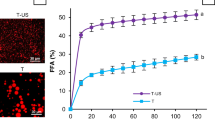Abstract
Surface active properties such as surface and interfacial tension reductions and stability of oil-in-water (o/w) and water-in-oil (w/o) emulsions by alkyl glycoside fatty acid polyesters, a potential fat substitute, and emulsifier blends of alkyl glycoside polyesters and Ryoto sugar esters were investigated.
Our results indicate that blending of lipophilic and hydrophilic emulsifying agents produces a synergistic effect on reduction of surface and interfacial tensions and may, in some cases, result in more stable emulsions. Alkyl glycoside polyesters may be suitable for w/o emulsions, such as margarine and butter, and their blends with hydrophilic emulsifiers will produce reduced calorie emulsifiers suitable for use in o/w emulsions, such as salad dressing. There appears to be great potential for using such emulsifier blends in food, cosmetics and pharmaceutical applications.
Similar content being viewed by others
References
Gibbons, J.P., and C.J. Swanson,J. Am. Oil. Chem. Soc. 36:553 (1959).
Albano-Garcia, E., R.G. Lorica, M. Pama and L. de Leon,Phillip. J. Coconut Stud. 5:51 (1980).
Akoh, C.C., and B.G. Swanson,J. Am. Oil Chem. Soc. 66:1295 (1989).
Akoh, C.C., and B.G. Swanson,J. Nutr. Biochem., in press.
Nawar, W.W., inFood Chemistry, edited by O.R. Fennema, Marcel Dekker, Inc., New York, 1985, pp. 139–244.
Gupta, R.K., K.A. James and F.J. Smith,J. Am. Oil Chem. Soc. 60:862 (1983).
Rosen, M.J.,Surfactants and Interfacial Phenomena, John Wiley and Sons, New York, 1989, pp. 207–336.
Alexander, A.E., and J.B. Hayter, inPhysical Methods of Chemistry, John Wiley and Sons, New York, 1971, pp. 501–555.
Akoh, C.C.,J. Am. Oil Chem. Soc. 69:9 (1992).
Akoh, C.C., and B.G. Swanson,J. Food Sci. 52:1570 (1987).
Osipow, L., F.D. Snell, D. Marra and W.C. York,Ind. Eng. Chem. 48:1462 (1956).
Noro, S., A. Takamura and M. Koishi,Chem. Pharm. Bull. 27:309 (1979).
Hill, C.G., R. Hedinsdottir and C.H. Amundson,J. Food Proc. Pres. 11:111 (1987).
Ryoto Sugar Ester Technical Information, Mitsubishi-Kasei Food Corporation, Tokyo, 1987, pp. 1–20.
Author information
Authors and Affiliations
About this article
Cite this article
Akoh, C.C., Nwosu, C.V. Emulsification properties of polyesters and sucrose ester blends II: Alkyl glycoside polyesters. J Am Oil Chem Soc 69, 14–19 (1992). https://doi.org/10.1007/BF02635869
Received:
Accepted:
Issue Date:
DOI: https://doi.org/10.1007/BF02635869




